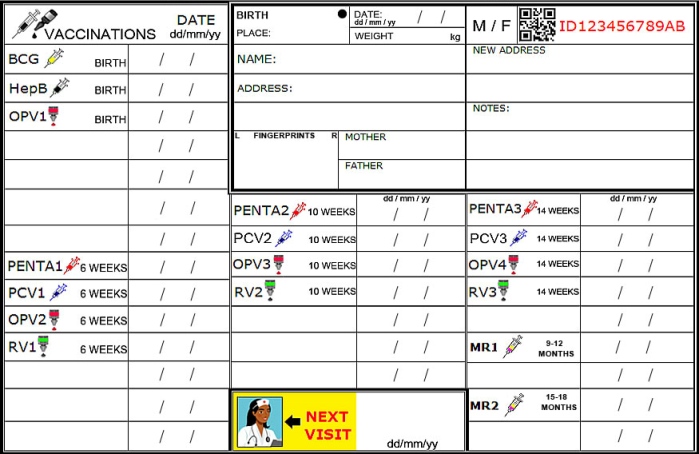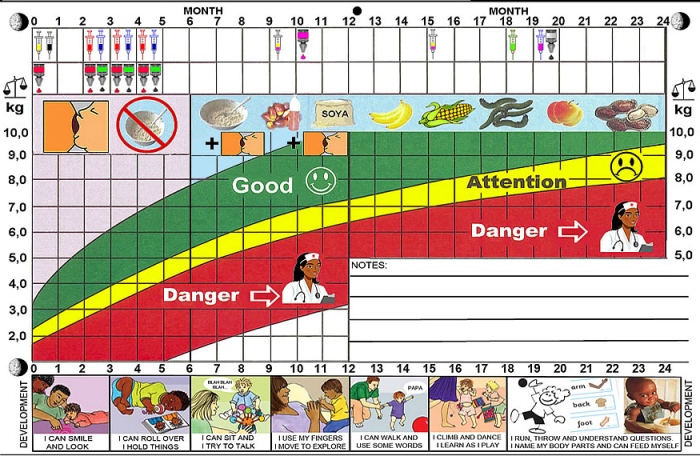A Better Way to promote, save, and analyse Infant Health


This is my application for the Gates Foundation's "Records for life" challenge to design a better Child Health Record (CHR) in the autumn of 2013. I was not selected as one of the winners but hope some of these ideas find their way into use as I think they have several advantages.
The first innovation in my design is the use of self-contained carbonless coated card inside a lamination film. This allows writing to be recorded through the protective film so that it cannot be damaged by the environment (water, dirt etc.) It requires firm pressure with a ball-point pen or pencil to activate the carbonless layer.
The CHR could be supplied already sealed (lower cost and less work for users) or they could be left partly open to allow permanent data to be written directly on the paper and the fingerprint sticker could be placed inside the lamination film before sealing. To seal the CHR, remove the release paper from the top film and carefully smooth the self-adhesive film onto the paper CHR and lower protective film below. Pre-sealed CHRs would be easier to use but would not protect the fingerprints and permanent data as securely.
For my samples, I used readily available self-adhesive films (3M Scotch polyester self-laminating pouches.) For a mass produced CHR, we would test and custom specify the plastic type and thickness used to optimise the balance of cost, protection and ease of use. A thinner, softer film would require less pressure from the pen or pencil to activate the carbonless layer.
The second main innovation is the use of an RFID memory chip to digitally store (and back up) all data. The stiffer section at the top centre section of the CHR is an RFID memory card. The card used is a standard credit card size but a custom plastic card could be the full size of the CHR to add strength or adjusted to fit the permanent data sections. This RFID (or Near Field Communication - NFC) chip would store all of the person's health data and this data can be synchronised to a database when at an online clinic or synchronised via handheld reader/writers in the field. The data can later be transferred to an adult health ID card.
The fingerprints and ID number are unique to each child. The ID number is pre-printed on the CHR in characters and in QR code as well as being on the RFID chip for rapid, automated linking to a database. Fingerprints are stored as ink or inkless prints on paper stickers and can be stored in the CHR's RFID memory using already available fingerprint feature extraction software. A properly equipped smartphone or other computer could read the QR code, the RFID card or the fingerprint images for rapid synchronization with a database where and when available. The permanent data is hard to change or damage as it is written on normal paper (not carbonless) or a deactivated carbonless section which is sealed inside the lamination.
The fingerprint stickers would allow only clear, non-smudged prints to be added to the CHR. In my own testing it took some practice to get a clean print so it would be easier bringing small stickers to the baby rather than a large CHR. A print can be discarded if smudged and only good prints put on the CHR.
All compulsory vaccinations can be pre-printed on the CHR while extras can be added manually. Date boxes are large and the dating format is clear and standardised to facilitate automated reading into a database at a later stage in case the RFID memory chip is not used. Colour-coded vaccination and other action reminders are pre-printed or written in the timeline boxes at the top rows on the back of the CHR and these boxes can be marked by the health practitioner once completed. These marked boxes will speed automated visual reading of the CHRs if required.
The child's weight can be added directly onto the graph or written in the notes section or even added as an extra row on the timeline. All of the vaccinations, weights and notes can also be stored on the RFID card where the reader/writers are available. These are available for computers (under $20) or smartphones (under $40.) A bespoke battery-powered reader/writer could also be produced for under $50.
To ensure the card is not lost and is available for the health workers, it is bright yellow and has a fluorescent yellow ribbon. The bright ribbon ensures that the CHR is more visible, even when it is in a pile. The CHR can be hung on a hook for safety. The ribbon hole is through the edge of the RFID card (without damaging the RFID coil or chip) and this reinforces the ribbon hole.
The "NEXT VISIT" box is very prominent, is plain paper (not carbonless) and the date (and time if required) would be written in permanent marker on top of the lamination film. This date can be wiped off with a little alcohol or by hard rubbing with a cloth or paper towel. A new date and time would then be written here with a marker. Alternatively small stickers with the date and time can be placed on the "NEXT VISIT" box with new stickers covering the old.
Special instructions regarding feeding can be added to the back of the CHR to the food row or to the notes. An example would be to cross out breast feeding if the mother is HIV positive and the local guidelines recommend this.
Since each CHR's unique number would be registered at birth and at each visit along with details of vaccinations, weights and other details, it is very easy for administrations to have real-time access to coverage level if the data is consolidated into one or more databases on a regular basis. If the RFID cards are used, the data is stored in both the CHR and in the database which gives one level of redundancy should either fail. It also makes it easier if people move or are displaced. A new CHR can also be printed and the data written to the new RFID card should a CHR be lost.
As well as the types and dates of vaccinations required and the date for the next visit, parents can see on the CHR what foods they should give their child during each stage and what weight the child should be if it is healthy. Food types in the food row can be adjusted to match the locally available foods. The weight graph on the back prompts parents to seek help if the weight is in the dangerous red area.
Typical development stages are also shown on the timeline to help parents recognise problems early on and also to show parents what their children should be doing and how they learn at each stage. These examples are some I found online but they can be adapted to the local conditions and traditions.
New vaccines and dose schedules can easily be added manually in the free boxes as well as on the timeline on the back of the CHR. This new data is also protected from the environment by the lamination film. If health clinics use small vaccine batch stickers, these can be added directly to the card (on top of the film) in the vaccine type box on the front of the CHR.
New vaccination and other schedules can also be updated to the RFID memory based upon local requirements, epidemics or child-specific health requirements. These can then be easily read and updated by any clinics or health practitioners having an RFID card reader/writer.
The database can mimic the CHR layout with the permanent data (name, DOB, birthplace and weight, ID, parents, address, fingerprints) being followed by a chronological list of vaccinations, weights and then unique health information notes for the child.
The combination of discrete data entry cells, colour-coded icons linking vaccinations to a timeline and the growth graph on the back of the CHR, all help people to become familiar with a typical digital database layout. The combination of simple pictures and symbols will be familiar to healthcare providers who use this CHR and the same can be used in the digital interface (possibly in a language-free version or with minimal use of words.)
The vaccination and actions timeline on the back as well as the indicated vaccinations on the front direct the healthcare provider to tell the parent the date of the next visit and write it in the "NEXT VISIT" box.
The use of the RFID memory card inside the CHR would make the transition to a digital system very easy since all of the relevant data is stored in the card and can easily be read into a database. A Mifare 1kb card is available for as little as $0,09 in volumes and the storage of the data on the card as well as on a database would ensure that the information is available even if the network/internet is not available or the database or electricity supply is down. Many handheld devices such as smartphones and stand-alone RFID readers are available to read and record the RFID cards and these devices could store many thousands of records for later synchronisation with a database.
If the RFID cards cannot be used for any reason, the strict positioning and format of all data will make automated reading of most data possible and only hand-written notes may have to be manually entered. The vaccination and action boxes on the back can be marked when the action is completed and the position of the mark in the box for pre-printed symbols would correspond to a specific vaccination or action so the marks could easily be read by a digital scan. Similarly, marks on the weight graph can be read by a scan and converted to a digital growth graph.